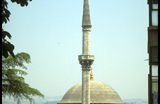|
The Turkish Baroque
Style:
The name given to the Ottoman architectural
and decorative production from the mid eighteenth century until the third
quarter of the nineteenth century. The style was concomitant with the
gradual Westernization of the Ottoman
elite's lifestyle and tastes is characterized by a profusion of curved,
undulating motifs, imported European patterns, and unrestrained, extroverted
plans.
Neo-Islamic Styles:
The nineteenth century started with the first European military interventions
in the Orient and ended with most of it under direct colonial rule. Architecture
was affected by these new political realities and by the disciplinary
developments in Europe where architecture had become an academic field
with its rules and parameters. European styles began shaping the outlook
of "Oriental" cities and the tastes of their inhabitants. Also European
and European-trained designers became the masters of the building trades
everywhere. These same professionals acted as the interpreters of the
architectural heritage of the countries in which they worked. They documented,
analyzed, and classified the structures they encountered, which permitted
the introduction of these formerly-unexplored styles. Consequently, hybrid
styles of building and decoration were produced in both East and West
that borrowed freely and sometimes indiscriminately from the varied repertoires
of non-western architectures, and blended them with various European structural,
constructional, functional, and stylistic modes. The end results came
to be known collectively as Oriental styles and individually we encounter
various epithets such as the Neo-Moorish, Neo-Saracen, Neo-Mamluk,
Neo-Mughal and so on.
|
|
|
|
|




